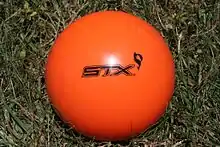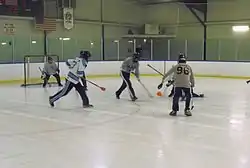Broomball
Broomball is a recreational ice game. It is played in a hockey rink, either indoors or outdoors, depending on climate and location.[1]


In a game of broomball there are two teams, each consisting of six players: a goaltender and five others. The object of the game is to score more goals than the opponent. Goals are scored by hitting the ball into the opponent's net using the broom. Tactics and plays are similar to those used in sports such as ice hockey, roller hockey and floorball.
Players hit a small ball around the ice with a stick called a "broom." The broom may have a wooden or aluminum shaft and has a rubber-molded triangular head similar in shape to that of a regular broom (or, originally, an actual corn broom with the bristles either cut off or covered with tape). Players wear special rubber-soled shoes instead of skates, and the ice is prepared in such a way that it is smooth and dry to improve traction. The ball can differ whether the game is played indoors or outdoors. The indoor ball is smooth while the outdoor ball has ridges and resembles a small soccer ball.
Gameplay

A typical game of broomball is broken up into two or three periods. Each team has a goaltender plus five other players, typically two defenders and three attackers (two forwards and one centre). If the ice surface is especially small, some leagues use fewer players on the ice.
The object of the game is to score goals into the opponent's goal or net. The team with the most goals at the end of a game is declared the winner. In some tournaments, if the scores are tied after regular time, an additional overtime period is played to determine a winner. In the overtime period (in most cases), six players, three on each team, play five minutes without a goalie. The team to score more goals in the overtime period is declared the winner. In the event of another tie, a second overtime period may be played. In some games a shootout period will be played. The shooter has the choice to have the ball placed a specified distance from the net or, like in hockey, can play the ball from centre ice.
Goaltender equipment
Goaltenders generally wear a full face cage in addition to thick padding on the legs, thighs, chest and shoulders. Goaltenders are permitted to use a blocker, a specially designed rectangular glove attachment that is used to block shots. A blocker is similar to those used by ice-hockey goalies.
Officials
Broomball games are controlled by two on-ice referees. Both referees have the same powers to call all penalties, off-sides, goals, and so on. There usually are off-ice officials as well, depending on the level of the game being played, including a scorekeeper, a timekeeper, a penalty timekeeper, and goal judges.
Referees are generally required to wear black and white vertical-striped jerseys, with a red arm band on one arm. They use this arm to signal penalties throughout the game.
History
There is no known fully accurate history of broomball. The exact origin of the sport has been difficult to pin point. The First Nations peoples of Canada are believed to have passed the sport on to the settlers. The first recorded broomball games in North America were in Perdue, Saskatchewan on March 5, 1909[2] From Canada the game spread south to the United States, becoming especially popular in Minnesota, where by the 1960s a broomball community was thriving.[3]
Broomball spread internationally over the following decades, and by the 1980s, organized broomball was being played in Australia,[4] Japan, Sweden, Italy,[5] Germany,[5] and Switzerland.[6]
World governing body
The International Federation of Broomball Associations (IFBA) is the world governing body of broomball. Its headquarters are in Canada.
Every two years the IFBA runs the World Broomball Championships (also known as the Challenge Cup), an international event with teams from around the world. Historically, the championships have been dominated by the North Americans teams.
United States governing body
The American organization recognized by the IFBA is USA Broomball. They are responsible for sanctioning tournaments, training and certifying officials, and recognizing state governing bodies regarding broomball. The states that currently have governing bodies recognized by USA Broomball include Colorado, Iowa, Michigan, Minnesota, Nebraska, New York, North Dakota, and Ohio. USA Broomball also organizes and oversees the annual USA Broomball National Championships. In odd-numbered years, Minnesota (the unofficial U.S. broomball capital and home to the majority of broomball leagues and teams in the country) hosts the National Championships. In even-numbered years, a different state with an officially recognized state organization hosts the tournament. Below is a list of recent hosts of the National Championships.
- 2004: Omaha, Nebraska
- 2005: Rosemount, Minnesota
- 2006: Westlake, Ohio
- 2007: Blaine, Minnesota
- 2008: Fargo, North Dakota
- 2009: Richfield, Minnesota
- 2010: Blaine, Minnesota
- 2011: Duluth, Minnesota
- 2012: Blaine, Minnesota
- 2013: Oxford, Ohio
- 2014: Blaine, Minnesota
- 2015: Fargo, North Dakota
- 2016: Minneapolis, Richfield, Minnesota
- 2017: Delmont, Pennsylvania
- 2018: Blaine, Minnesota
- 2019: Fargo, North Dakota
Broomball around the world

Broomball is now an established international recreational sport, played in many countries around the world. Canada and the United States are the "powerhouse" nations of the sport, with their local representative teams often battling in prestigious tournaments held annually across North America.
Broomball is becoming more popular internationally, as well. In Japan, some top teams and players are attracted to regular tournaments. Australia holds its annual National Championships in centres across the country and is continually increasing its number of players in a country where ice sports are not considered popular. Switzerland and Italy regularly send representative teams to tournaments in North America. The UK hosts nights of fun games at the Broadgate Ice rink in the City of London, which attracts North American players, city workers and people just wanting to give a new sport a try.
Broomball is played at many universities, including: Miami University, Iowa State University,[7] The University of Notre Dame,[8] Michigan Technological University, The University of Texas at Austin, Rochester Institute of Technology, University of Chicago, University of Nebraska-Lincoln, and Boston University.[9]
Other broomball nations include Finland, Germany and Russia.
IFBA Rules vs USA Rules
There are two main differences between IFBA gameplay and USA Broomball gameplay: the way offsides works, and the size of the net. Under IFBA rules, the red line (center ice) is the only line used to determine offsides. Once the offensive team clears the red line, the defense must work to get it back over the same line. In USA broomball, a "floating blue line" is employed, meaning the offensive team must pass the blue line, and then the defense must work to get it back over the red line. The other major difference is the size of the nets. IFBA sanctioned games use a 5'x7' net, while USA Broomball uses 6'x8 nets. While there are other slight differences, these two are by far the biggest. The results of these rules are generally considered to effect the game by making both the score and the pace of play slightly slower under IFBA rules.
References
- "Home – St. Claude Broomball". Stclaudebroomballmb.com. 2014-02-03. Retrieved 2014-08-17.
- tgsen. "Broomball Association of South Australia - What is Broomball". www.basa.org.au. Retrieved 19 March 2018.
- "History of Broomball - USA Broomball". www.usabroomball.com. Retrieved 19 March 2018.
- "激安チラシ印刷でお得に宣伝広告|お店を魅力的に見せる宣伝方法". www.broomballaustralia.org. Retrieved 19 March 2018.
- "History of Italian broomball". Archived from the original on August 25, 2007.
- "Broomball.ch - Association Suisse de Broomball". www.broomball.ch. Retrieved 19 March 2018.
- McConnell, Jana (2006-02-07). "Much more than fun and games". Ames, IA: Iowa State Daily. Retrieved 2018-01-23.
- Dame, ENR/PAZ // University Communications: Web // University of Notre. "Intramural Sports // RecSports // University of Notre Dame". recsports.nd.edu. Retrieved 19 March 2018.
- Carsley, Ben. "Sneakers on Ice". Boston University. Retrieved 2014-08-17.